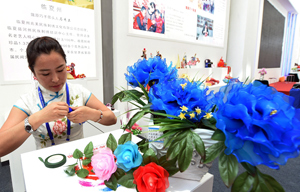Cities
Tianshui
Updated: 2015-09-17( chinadaily.com.cn )
The city of Tianshui is located in southeast Gansu province. It is considered the "East Gate" of Gansu. It covers an area of 14,300 square meters. There are 28 ethnic groups living in the city. Tianshui is located at the juncture of the gully regions in the southern part of the Loess Plateau and West Qingling Mountain. It sits across from the Yangtze River and Yellow River, with the West Qingling Mountain as the watershed. The mountainous city's altitude runs high to low from northwest to southeast, 1,000 to 2,100 meters above sea level. The annual average precipitation is 574 millimeters, and the annual average sunlight is 2,100 hours. The Weihe River within the city is about 280 kilometers long and has a drainage area covering 1,000 square meters.
The total area of the forest in the city is 393,273 hectares. It is home to more than 800 kinds of plants, including 312 varieties of arbor, 437 kinds of shrubs, 55 vines and 122 evergreen plants. There are more than 660 types of wild medicinal plants, among which more than 220 are for common use. Various rare and valuable animals live in the forest.
Tianshui, an important birthplace of Chinese civilization, has over 8,000 years of ancient history, 3,000 years of written recorded history. The main historical cultures in the city include Fu Hsi Culture, Dadiwan Primal Tribe Culture, the early culture of the Qin State (one of the vassal states from 900-206 BC) , Grottoes Artistic Culture, and Ancient War Culture during the Three Kingdoms period (AD 220-280). The city has many ancient cultural relics, constructions, tombs and war sites. The Dadiwan Primal Tribe Ruins, located in Tianshui, date back roughly 4,800 to 8,300 years. The Maiji Mountains scenic spots, also located in Tianshui, were approved as the first batch of key scenic spot areas in the country in 1982. The Maiji Mountain Grottoes are one of the four great grottoes in China, honored as an "Oriental Sculpture Museum". It is now seeking approval from the UN as a historical, cultural and natural world heritage.
History: Tianshui is said to have been the hometown of Fuxi, one of ancient China's three wise kings. As such, the city is praised as the root of ancient Chinese culture. In 688 BC historical records referenced the city (though it was then called Qinting). The name 'Tianshui' appeared during the Qin Dynasty (221BC-206BC) when it was given the name Tianshui Shire.
Physical Features: The southern and eastern parts of the city are mountainous, while the north is a loess hilly area (with soil comprised mainly of wind-blown sediment). A fraction of the central area lies in the river valley. As a whole, the city's terrain slopes downward, from northwest to southeast.
Tianshui Yuquan Temple Climate: Enjoying a temperate continental climate, the city has distinct seasons, with extreme heat appearing in July, fading into an overcast and rainy autumn. The yearly temperature is around 11C (52F).
Economy: In 2011, the city's GDP reached 35.76 billion yuan ($5.87 billion), a year-on-year increase of 12 percent. The added value of the primary industry was 6.7 billion yuan, an increase of 7.6 percent year-on-year. That of the secondary industry was 14.22 billion yuan, a 14.8 percent increase; the tertiary industry was 14.84 billion yuan, an 11.5 percent increase. The ratio of the three industries was 18.7-to-39.8-to-41.5. The industrial added value of large industrial enterprises in the city reached 7.38 billion yuan in 2011, a year-on-year increase of 14.1 percent. Completed fixed asset investment amounted to 32.2 billion yuan in 2011, growing 34.63 percent since 2010.
Social undertakings: There were three colleges and 18,700 students in Tianshui as of 2011. The city has organized 326 scientific and technological programs above the municipal level, with 208 innovative achievements. Tianshui has 36 national-level and provincial-level engineering research centers and enterprise technology centers, one provincial-level key lab, 11 national-level and provincial-level innovation-oriented companies and pilot enterprises, and 20 high-tech enterprises.
The city has a total of eight cultural and artistic performance troupes, eight cultural museums, eight public libraries, and 405 medical and health organizations.
There are 137 sports facilities where citizens can exercise. Tianshui athletes have made significant achievements in competitions above the provincial level.



